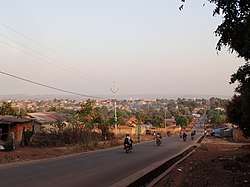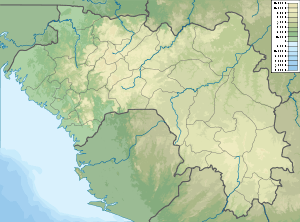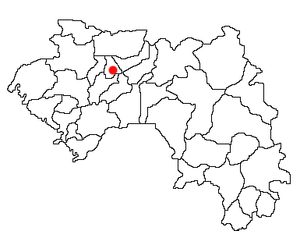Labé
Labé (N’ko: ߟߊߓߋ߫) is the main city and administrative capital of the Fouta Djallon region of Guinea. It has a population of about 200.000. It is the second largest city in the country after the capital Conakry in term of economic importance. Labé is situated some 450 km northeast of Conakry close to the geographic centre of Guinea.
Labé | |
|---|---|
 Labé | |
 Labé | |
| Coordinates: 11°19′N 12°17′W | |
| Country | |
| Region | Fouta Djallon |
| Population (2014 census) | |
| • Total | 200.000 |
| Time zone | UTC±0 (UTC) |
History
The city was founded around 1755 by Karamoko Alpha mo Labé, a Muslim religious leader who introduced Islam in the region in the 18th century and who also founded a theocratic state in Fouta Djallon.
The city was the capital of the Diwal/province of Labe prior to French colonisation. It was home to Muslim leaders and scholars who resisted colonisation, such as Alpha Yaya Diallo. Labe is the most important city in the Moyenne (Middle) Guinea region also known as Fouta Djallon. Labe is considered as a major cultural and religious center in West Africa, especially among the Fulani people. Many Muslim scholars made Labe a famous learning place in Islamic studies. The most prominent of the erudites being Alfa Oumarou Rafiou (Dara Labe), Thierno Doura Sombili, Thierno Diawo Pellel, Thierno Aliou Bhouba Dian.
Economy
Labé is an important commercial centre in the region, arising out of its strategic geographical position between several other countries. Traders from nearby regions such as Pita, Tougué, Koubia, Lélouma, Mali Yemberin and other countries including Mali, Senegal, the Gambia and Sierra Leone gather in Labé. Its central market is the second largest in the country after the Madina market in Conakry. Trade or commerce has become the main activity in the city, but Labe also has a small manufacturing industry consisting mainly of shoe making, textile, carpentry, blacksmithing... It is known for weaving and honey. The city also benefits from a considerable diaspora whose repatriated income contributes significantly to infrastructural development in Labé and helps to overcome the region's relatively poorer revenue stream. Merchants from the city dominate the informal economy in most Guinean cities and are also economically active in cities further afield, such as Dakar, Bamako, Abidjan, Bissau and Freetown.
The city also has a museum, while the Saala Falls and Mount Kolima lie nearby.
The town is served by Tata Airport. A jet-capable airport near Labé was built by Cuban engineers in 1973. Currently the airport remains unused due to the lack of airline traffic connecting the different regions and major cities in Guinea.
The city has a sizable stadium (stade Saifoulaye Diallo) which hosts soccer/football games played by the local club Fello Star. However the sport facility is poorly maintained and kept.
Climate
Labé has a tropical savanna climate (Köppen climate classification Aw) with extreme differences between day and night. It is hot all year round (yet cold to warm at night). About 1500 mm of rain fall annually, mostly on summer.
| Climate data for Labé, Guinea | |||||||||||||
|---|---|---|---|---|---|---|---|---|---|---|---|---|---|
| Month | Jan | Feb | Mar | Apr | May | Jun | Jul | Aug | Sep | Oct | Nov | Dec | Year |
| Average high °C (°F) | 31.8 (89.2) |
33.3 (91.9) |
34.4 (93.9) |
34.4 (93.9) |
33.8 (92.8) |
30.8 (87.4) |
28.3 (82.9) |
27.7 (81.9) |
28.2 (82.8) |
28.8 (83.8) |
31.0 (87.8) |
30.5 (86.9) |
31.1 (88.0) |
| Daily mean °C (°F) | 19.4 (66.9) |
21.3 (70.3) |
23.2 (73.8) |
26.1 (79.0) |
24.3 (75.7) |
22.9 (73.2) |
20.6 (69.1) |
21.5 (70.7) |
21.5 (70.7) |
21.6 (70.9) |
18.8 (65.8) |
19.1 (66.4) |
21.7 (71.1) |
| Average low °C (°F) | 5.7 (42.3) |
4.7 (40.5) |
5.2 (41.4) |
12.2 (54.0) |
15.1 (59.2) |
15.2 (59.4) |
15.0 (59.0) |
15.5 (59.9) |
14.8 (58.6) |
13.0 (55.4) |
8.4 (47.1) |
6.1 (43.0) |
10.9 (51.6) |
| Average precipitation mm (inches) | 2 (0.1) |
4 (0.2) |
9 (0.4) |
35 (1.4) |
141 (5.6) |
233 (9.2) |
315 (12.4) |
340 (13.4) |
288 (11.3) |
141 (5.6) |
34 (1.3) |
2 (0.1) |
1,544 (60.8) |
| Average precipitation days (≥ 1.0 mm) | 0 | 0 | 1 | 3 | 11 | 15 | 20 | 22 | 21 | 12 | 2 | 1 | 108 |
| Average relative humidity (%) | 38 | 37 | 40 | 43 | 64 | 74 | 86 | 82 | 81 | 77 | 71 | 47 | 62 |
| Mean monthly sunshine hours | 270 | 256 | 261 | 232 | 211 | 180 | 148 | 131 | 159 | 195 | 236 | 257 | 2,536 |
| Source: NOAA[2] | |||||||||||||
Notable people
- Siradiou Diallo (1936–2004) – politician and journalist
- Alpha Oumar Barou Diallo – politician
- Cellou Dalein Diallo – politician and economist
- Koumanthio Zeinab Diallo – poet, novelist and playwright
- Elhadj Thierno Abdourahmane Bah (1916 - 2013) - Poet and imam of Labe mosque
- Saidou Malea Diallo - Professor
- Ibrahima Caba Bah - Professor
- Karamoko Alfa Mo Labe - Founder of the town
- Elhadj Thierno Badrou Bah - Current imam of Labe
References
| Wikimedia Commons has media related to Labé. |
- Harold D. Nelson, Area Handbook for Guinea, Department of the Army Pamphlet 550-174, 1975, p.333
- "Labé Climate Normals 1961–1990". National Oceanic and Atmospheric Administration. Retrieved March 8, 2015.
